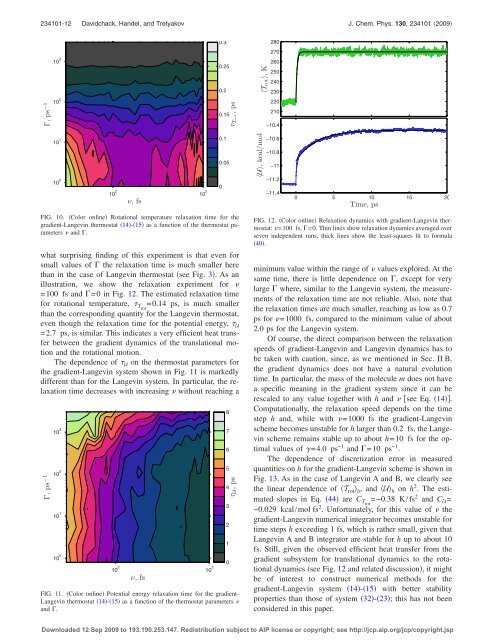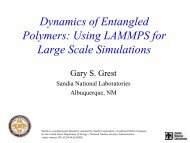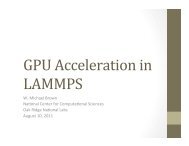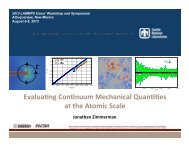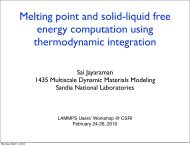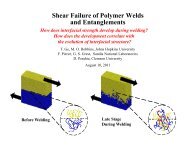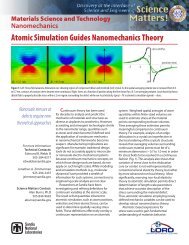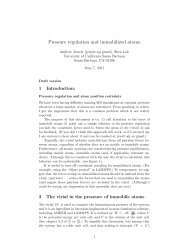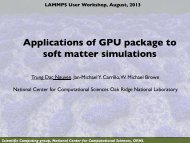Langevin thermostat for rigid body dynamics - Lammps
Langevin thermostat for rigid body dynamics - Lammps
Langevin thermostat for rigid body dynamics - Lammps
You also want an ePaper? Increase the reach of your titles
YUMPU automatically turns print PDFs into web optimized ePapers that Google loves.
234101-12 Davidchack, Handel, and Tretyakov J. Chem. Phys. 130, 234101 2009<br />
0.3<br />
280<br />
270<br />
10 3 ν, fs<br />
0.25<br />
0.2<br />
Trot, K<br />
260<br />
250<br />
240<br />
230<br />
Γ, ps −1<br />
10 2<br />
0.15<br />
τTrot<br />
,ps<br />
220<br />
210<br />
−10.4<br />
10 1<br />
10 0<br />
10 2 10 3<br />
0.05<br />
FIG. 10. Color online Rotational temperature relaxation time <strong>for</strong> the<br />
gradient-<strong>Langevin</strong> <strong>thermostat</strong> 14-15 as a function of the <strong>thermostat</strong> parameters<br />
and .<br />
what surprising finding of this experiment is that even <strong>for</strong><br />
small values of the relaxation time is much smaller here<br />
than in the case of <strong>Langevin</strong> <strong>thermostat</strong> see Fig. 3. Asan<br />
illustration, we show the relaxation experiment <strong>for</strong> <br />
=100 fs and =0 in Fig. 12. The estimated relaxation time<br />
<strong>for</strong> rotational temperature, Trot =0.14 ps, is much smaller<br />
than the corresponding quantity <strong>for</strong> the <strong>Langevin</strong> <strong>thermostat</strong>,<br />
even though the relaxation time <strong>for</strong> the potential energy, U<br />
=2.7 ps, is similar. This indicates a very efficient heat transfer<br />
between the gradient <strong>dynamics</strong> of the translational motion<br />
and the rotational motion.<br />
The dependence of U on the <strong>thermostat</strong> parameters <strong>for</strong><br />
the gradient-<strong>Langevin</strong> system shown in Fig. 11 is markedly<br />
different than <strong>for</strong> the <strong>Langevin</strong> system. In particular, the relaxation<br />
time decreases with increasing without reaching a<br />
Γ, ps −1<br />
10 3<br />
10 2<br />
10 1<br />
10 0<br />
ν,fs<br />
10 2 10 3<br />
0.1<br />
0<br />
8<br />
7<br />
6<br />
5<br />
τU, ps<br />
FIG. 11. Color online Potential energy relaxation time <strong>for</strong> the gradient-<br />
<strong>Langevin</strong> <strong>thermostat</strong> 14-15 as a function of the <strong>thermostat</strong> parameters <br />
and .<br />
4<br />
3<br />
2<br />
1<br />
0<br />
U, kcal/mol<br />
−10.6<br />
−10.8<br />
−11<br />
−11.2<br />
−11.4<br />
0 5 10 15 20<br />
Time, ps<br />
FIG. 12. Color online Relaxation <strong>dynamics</strong> with gradient-<strong>Langevin</strong> <strong>thermostat</strong>:<br />
=100 fs, =0. Thin lines show relaxation <strong>dynamics</strong> averaged over<br />
seven independent runs, thick lines show the least-squares fit to <strong>for</strong>mula<br />
40.<br />
minimum value within the range of values explored. At the<br />
same time, there is little dependence on , except <strong>for</strong> very<br />
large where, similar to the <strong>Langevin</strong> system, the measurements<br />
of the relaxation time are not reliable. Also, note that<br />
the relaxation times are much smaller, reaching as low as 0.7<br />
ps <strong>for</strong> =1000 fs, compared to the minimum value of about<br />
2.0 ps <strong>for</strong> the <strong>Langevin</strong> system.<br />
Of course, the direct comparison between the relaxation<br />
speeds of gradient-<strong>Langevin</strong> and <strong>Langevin</strong> <strong>dynamics</strong> has to<br />
be taken with caution, since, as we mentioned in Sec. II B,<br />
the gradient <strong>dynamics</strong> does not have a natural evolution<br />
time. In particular, the mass of the molecule m does not have<br />
a specific meaning in the gradient system since it can be<br />
rescaled to any value together with h and see Eq. 14.<br />
Computationally, the relaxation speed depends on the time<br />
step h and, while with =1000 fs the gradient-<strong>Langevin</strong><br />
scheme becomes unstable <strong>for</strong> h larger than 0.2 fs, the <strong>Langevin</strong><br />
scheme remains stable up to about h=10 fs <strong>for</strong> the optimal<br />
values of =4.0 ps −1 and =10 ps −1 .<br />
The dependence of discretization error in measured<br />
quantities on h <strong>for</strong> the gradient-<strong>Langevin</strong> scheme is shown in<br />
Fig. 13. As in the case of <strong>Langevin</strong> A and B, we clearly see<br />
the linear dependence of T rot h , and U h on h 2 . The estimated<br />
slopes in Eq. 44 are C Trot =−0.38 K/fs 2 and C U =<br />
−0.029 kcal/mol fs 2 . Un<strong>for</strong>tunately, <strong>for</strong> this value of the<br />
gradient-<strong>Langevin</strong> numerical integrator becomes unstable <strong>for</strong><br />
time steps h exceeding 1 fs, which is rather small, given that<br />
<strong>Langevin</strong> A and B integrator are stable <strong>for</strong> h up to about 10<br />
fs. Still, given the observed efficient heat transfer from the<br />
gradient subsystem <strong>for</strong> translational <strong>dynamics</strong> to the rotational<br />
<strong>dynamics</strong> see Fig. 12 and related discussion, it might<br />
be of interest to construct numerical methods <strong>for</strong> the<br />
gradient-<strong>Langevin</strong> system 14-15 with better stability<br />
properties than those of system 32-23; this has not been<br />
considered in this paper.<br />
Downloaded 12 Sep 2009 to 193.190.253.147. Redistribution subject to AIP license or copyright; see http://jcp.aip.org/jcp/copyright.jsp


